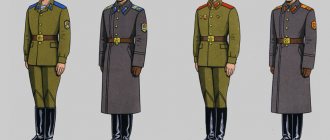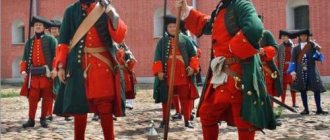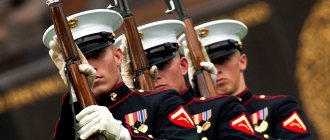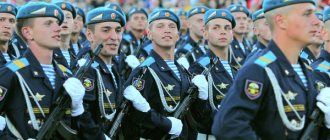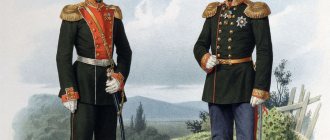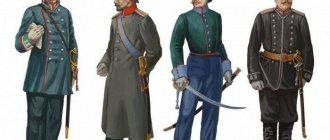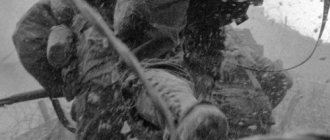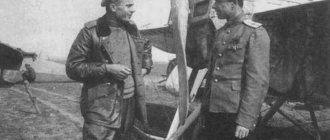History of naval dress
The history of the Navy uniform dates back to the time of Peter the Great. By order of the powerful emperor-manager, in 1696 the Boyar Duma decided to create the first navy in the Russian state. October 30 is traditionally considered the founding day of the Russian Fleet.
With its creation, Peter I introduced a uniform for sailors and lower ranks, created from items of naval clothing of Dutch naval employees, namely a gray or green jacket made of coarse wool, short green pants, stockings and a wide-brimmed hat. The footwear for naval employees was leather shoes. This set was also replaced by a casual work suit. It included a loose shirt, canvas trousers, a cocked hat and a camisole. The sailors wore it during Ushakov’s Mediterranean campaign.
The work uniform, which included a set of gray canvas trousers and a shirt, was worn during any ship work; a uniform white shirt with an azure collar was put on top of it. This suit was approved as a uniform for privates in the summer of 1874.
SAMPLES OF CLOTHING UNIFORMS FOR PERSONNEL OF THE RKKA NAVY OF 1934-1939
Middle, senior and senior management
Junior commanding officers (K-2) of long-term service. Since 1935 - Junior platoon commander and Sergeant major of long-term service.
Cadets of naval schools
Junior commanders and enlisted personnel of conscript and long-term service
About Navy uniform fabrics
Until the 80s of the 20th century, military everyday work uniforms for military personnel of the Russian Navy were made from lightweight canvas, which was easy to clean from the most difficult stains. The Black Sea Fleet was dressed in white work clothes, the rest - most often in blue. A little later, the color of the uniform changed to blue/dark blue, and the material became predominantly cotton fabric. The new uniform is sewn in a variety of workshops, using all sorts of materials that are not always of good quality. The new (currently approved) uniform can be of any color ranging from shades of black and blue.
History of the Marine Corps
At the beginning of the 18th century, the Russian army used Peter’s infantry regiments to enter the Baltic Sea, which successfully completed their task and drove the Swedes out of that water area. This is how the Marine Corps was formed, and in 1705 Peter 1 issued a decree on its creation.
In 1804, the naval regiments were sent as reinforcements to the Mediterranean Sea to the squadron of D.N. Senyavin. The Russian fleet and its marine corps were able to prevail in battles with superior forces of the enemy fleet. Also, the domestic marines took part in the confrontation for access to the Sea of Azov.
Army photos on Shutterstock: Army and military photos.
Landing of BTR-82A 2KBF during Marine Corps exercises in the Baltic Sea
Admiral F.F. Ushakov, during his Mediterranean campaign in 1798-1800, had at his disposal, including marines. Thanks to those military operations, the Ionian Islands were liberated, naval units took the impregnable fortress of Corfu and Naples with Rome.
The naval guards crew participated in the war from 1812 to 1814, and the first Russian flag erected in Paris was the St. Andrew's naval flag. The naval units went through the entire Russian-Turkish war from 1877 to 1878.
In 1917, the Soviet Marine Corps appeared, which took an active part in the civil war, and later, in 1940, in the Soviet-Finnish war.
During the Great Patriotic War, the Soviet command often used marine units for combat operations on land in extremely difficult situations at the front. They were highly resilient and instilled fear in the German troops. In modern history, the Marine Corps has participated in combat operations in various hot spots.
The assault on the fortified coastline by modern-day marines
Sailor casual uniform
What is the most common new naval suit for 2022? A naval suit, or in the jargon of Navy personnel, a work dress (also a sailor's robe) is a form of working clothing for sailors, cadets of naval schools, as well as petty officers of the Russian Navy. A sailor's suit consists of the following items of clothing:
- Shirt.
- Trousers.
- Sailor collar.
- Shoes.
- Headdress.
Sailor's Shirt
The shirt, worn, as a rule, with a special button-down collar, is cut like a classic sailor's shirt. Its back and one-piece front are without seams, with a wide turn-down collar. There is a patch pocket in front, and an internal pocket on the reverse side. There is a slit that fastens with a button. The shirt sleeves are straight, set-in; simple shoulder straps corresponding to the rank. A mandatory element of sailor clothing is a white tag with an indelible combat number. Such a shirt is worn untucked, and during service on watch it must be tucked into the pants. In cold weather, an overcoat, peacoat or coat is worn over the set.
Sailor's trousers
Sailor's work trousers are made of dark blue cotton fabric. They have side pockets, fasteners located on the codpiece, as well as a belt with special loops (belt loops) for the belt. The belt is made mainly from pigskin, and on its plaque is the emblem of the Russian Navy. The buckle of the model that existed in the USSR depicted an anchor with a star.
Sailor's collar
The collar is also made of cotton material, worn over the shirt, has a lining and three white stripes, symbolizing the victories of the Navy in such battles as Chesme, Gangut and Sinop. Dress naval clothing also includes a sailor collar.
Sailor's headdress
There are several hats in Navy uniforms. One of them is a trump cap, to which is attached a ribbon with the name of the ship or with the inscription “Navy”. The tape is put on the band. It, like the bottom and walls, is made of wool. On the crown of the headdress there is a cockade representing a golden anchor. In the USSR, the cockade had the shape of a so-called “crab” - a red star framed by golden-colored leaves. The summer cap is made of white fabric (comes with a replaceable cover). The winter headdress is a black fur hat with earflaps.
In 2014, plans were made to introduce a wool hat to replace the earflap hat for outdoor work. Also in 2014, other developments of a new form were carried out, but some innovations did not take root.
In addition, the casual uniform set includes a beret.
The set of hats also includes a cap. On the front side of the cap there is a golden cockade in the shape of an anchor. In Soviet-era Navy uniforms, caps were intended for submarine crews. It was black in color and differed in type - for privates and for officers. Relatively recently, the cap was adopted as part of the uniform worn by the entire Navy. Its semicircular style was replaced with a rectangular one. The cap also received white piping, which was previously intended only for midshipmen and officers’ headdresses, as well as a cockade instead of a star.
Shoes
The above-described suit is accompanied by boots made of yuft leather, with thick soles, called “burnouts” or “bastards” in naval jargon. Not so long ago, boots were made with laces, but now, in 2020, they also have rubber inserts (they were introduced in 2014). In areas where the climate is harsh, military personnel wear cowhide boots. The tropical uniform includes wearing sandals.
Also included in the complete set of everyday uniforms is a striped vest, gloves and a hat with earflaps.
RULES FOR WEARING UNIFORM BY PERSONNEL OF THE RKKA NAVAL FORCES
Order on the Naval Forces Workers-Cross. Red Army No. 52 dated April 16, 1934 Moscow.
Description of uniforms for personnel of the Naval Forces of the Workers' and Peasants' Red Army
Uniform items for privates and junior commanding officers
- The overcoat is single-breasted, made of black cloth with six shaped metal buttons;
- Pea coat - double-breasted black cloth with 12 yellow brass buttons;
- Flannel shirt - made of dark blue wool flannel or cloth;
- The uniform white shirt is made of Flam white linen with a blue collar and cuffs with three white stripes;
- Black cloth trousers;
- White summer trousers;
- Working jacket made of blue calico for Navy engine teams - single-breasted made of blue calico, with one chest and two side patch pockets without flaps and a stand-up collar;
- Blue calico work trousers for Navy engine crews;
- Work shirt - made of gray canvas with a straight stand-up collar and one stitched chest pocket;
- Work trousers made of gray canvas;
- Vest - a knitted undershirt made of jersey with alternating dark and blue stripes of the same width;
- Cloth cap - made of black instrument cloth. A Red Army star is attached to the front of the cap above the band. A black rep silk ribbon is laid along the band of the cap. The name of the ship or fleet is stamped in gold on the ribbon, and anchors are on the free ends. In the summer, a white cap is worn over the cap.
- Cotton cap (summer) - the cut of a cloth cap;
- The hat is a “ear flap” made of black cloth with a nape, ears with braid and a visor made of dark “merlushka” fur. A Red Army star is placed in the middle of the visor.
- Boots are chrome;
- Boots;
- Waist belt made of glossy black leather, with brass or nickel-plated iron plaque with a stamped vertical anchor and star on top of the spindle;
- Wool gloves of dark colors;
- Black cloth tie with lined bib. Fastens at the back with 2 hooks.
Uniform items for commanding personnel of the Navy, including junior command personnel (K-2) for long-term service
- Overcoat – double-breasted from black overcoat cloth with 12 metal shaped buttons;
- Raincoat-coat - cut raincoat for the command staff of the Red Army. Made of rubberized cotton tunic fabric in gray color;
- Dark blue cloth jacket, single-breasted, with 5 shaped metal buttons and a stand-up collar (stand-up);
- White tunic made of bleached matting, single-breasted with 5 shaped metal buttons with a stand-up collar (stand-down);
- Black cloth trousers;
- The trousers are white;
- Jacket made of black cloth. double-breasted with 6 shaped metal buttons. When wearing a jacket, a white shirt with a collar and a black tie are worn;\
- Cloth cap made of black cloth. The cap consists of a band covered with a black rep ribbon, a crown sewn in four parts, a bottom, a black fiber varnished visor and a strap with two small shaped buttons. The bottom has an oblong shape with a difference between the major and minor axis of 2 cm. An emblem is attached to the band above the visor. Summer cap with a white top and removable cover. The remaining details are identical to the cloth cap. Canceled by order of the People's Commissar of the USSR Navy No. 426 of October 20, 1939.
- The cap for junior command personnel (K-1) of long-term service (K-2) of conscript service is the same as for commanding personnel, but without an emblem and ribbon, with a Red Army star on the band;
- Hat with ear flaps";
- Boots are chrome;
- Chrome boots;
- The badge for the cap and cap is the (emblem) of the command staff of the Navy; it consists of a gold-colored anchor with a red star above it, bordered on both sides by gold-colored ears of corn on a black oval field. The badge is embroidered, the anchor and star can be metal;
- Equipment for command personnel - from a waist belt, a holster for a revolver. Equipment color: black.
Dress codes vary depending on the season and purpose.
- According to the time of year, clothing is divided into summer and winter;
- By purpose - for everyday use and hiking;
The uniform of middle, senior and senior commanding personnel, as well as junior commanding personnel (K-2) of long-term service: foremen of groups, companies, batteries and teams, boatswains and chief boatswains of the naval forces, naval aviation, coastal defense units with 3- x summer service life.
Casual summer - Cap with a white cover, with a sign = emblem; The jacket is white; Cloth jacket; Cloth jacket; The shirt is white with a collar; long black tie; Vest; The trousers are white; Cloth trousers; The boots are black; Overcoat; Weapons and equipment assigned to command personnel;
Casual winter - Cloth cap with a sign-emblem; In cold weather, the cap is replaced with a hat with an emblem; Cloth jacket; Jacket; White shirt with collar; Long black tie; Vest; Cloth trousers; The boots are black; Overcoat; Gloves; Weapons and equipment assigned to command personnel;
Travel on a ship - Same as everyday;
Marching on the shore - The same as on the ship, gas mask and assigned weapons. During guard duty and walking on the shore, boots are replaced with high boots.
Uniform for enlisted and junior commanding officers of conscript and long-term service of the naval forces, naval aviation, and coastal defense units with a 3-year service life
Casual summer - Cloth or cotton cap with ribbons and a white cover and a Red Army star; Uniform shirt; Flannel shirt; Vest; The trousers are white; Cloth trousers; The boots are black; Pea coat; Waist belt with plaque;
Casual winter – Cap with ribbons; In cold weather, the cap is replaced with a cloth cap with a Red Army star; Uniform shirt; Vest; Flannel shirt; Cloth trousers; The boots are black; Overcoat; Waist belt with plaque; Dark colored gloves; Cloth tie;
Travel on a ship - Same as everyday;
Marching on the shore - Weapons and equipment assigned to command personnel;
Note
- In inclement weather and in other cases during the summer, an overcoat may be worn by special order of the command of the MS of the sea or flotilla;
- In the southern seas, under favorable climatic conditions, the MS command may allow the wearing of pea coats instead of overcoats in winter;
- At parades, by order of the command, dark-colored gloves may be replaced with white ones;
- Junior commanding officers of long-term service (K-1) and foremen of groups of all specialties of conscript service (K-2) wear cloth caps with a black fiber visor, without a ribbon on the band and with a Red Army star.
List of uniforms by numbers for private and junior commanding officers and cadets of military educational institutions
Uniform No. 1: From + 25 C and above – Cap, uniform shirt, vest, white trousers, boots and waist belt.
Uniform No. 2: from +20C to +25C – Cap, uniform shirt, vest, black trousers, boots and waist belt.
Uniform No. 3: from +15C to +20C – Cap, flannel and uniform shirts, vest, black trousers, boots and waist belt.
Form No. 4: from +10С to +15С – cap, flannel, uniform and warm shirts, vest, black trousers, boots, waist belt.
Form No. 5: from 0C to +10C – Cap, flannel shirt, vest and uniform shirt, black trousers, pea coat, boots and tie.
Form No. 6: from 0C to -6C – Cap, flannel and uniform shirts, vest, black trousers, overcoat, tie, gloves, boots and waist belt.
Form No. 7: from -6C to -10C – Hat or cap, flannel and uniform shirts, vest, black trousers, overcoat, tie, boots, gloves and waist belt.
Form No. 8: from -10C and below – Hat with the back of the head or cap, flannel, uniform, underwear and warm shirts, black trousers, overcoat, tie, boots, gloves and waist belt.
List of uniforms by numbers for commanding officers and students of the Military Medical Academy, SKKS and Parallel Courses of the Red Army Navy
Form No. 1: From + 25 C and above – Cap, white jacket, white trousers, boots.
Form No. 2: from +20C to +25C – Cap, white jacket, black trousers and boots.
Form No. 3: from +15C to +20C – Cap, dark blue cloth jacket, black trousers, boots.
Form No. 4: from +10C to +15C – Cap, dark blue cloth jacket, black trousers, boots.
Form No. 5: from 0C to +10C – Cap, dark blue cloth jacket, black trousers, overcoat and boots.
Form No. 6: from 0C to -6C – Cap, dark blue cloth jacket, black trousers, overcoat, boots and gloves.
Form No. 7: from -6C to -10C - winter hat or cap, dark blue cloth jacket, black trousers, overcoat, boots and gloves.
Form No. 8: from -10C and below - Hat with a lowered nape or cap, dark blue cloth jacket, black trousers, overcoat, boots and gloves.
Note:
- Uniform No. 1 applies to all seas and flotillas, except for the MSBM and the Northern Military Flotilla, whose command personnel are only allowed to wear it when out of formation;
- During the period of time announced for the summer uniform, all Navy personnel wear a white cap on their caps;
- Boots in the ranks are replaced with high boots, unless otherwise instructed;
- At temperatures below 0C, guards and watchmen wear overcoats, and at external posts - guard clothes and felt boots - as directed by garrison commanders (within the limits of the latter's unit commanders).
During the period of time established for the summer uniform, it is allowed to wear:
- Within ships, units, headquarters and departments, instead of a white jacket - a working jacket made of dark blue calico or diagonal;
- Only on ships, instead of white trousers, there are dark blue trousers made of calico or diagonal;
- A coat-coat of the established type, with official insignia and uniform buttons - only out of order;
- With white trousers - a dark blue cloth jacket and a black jacket - only when not on duty;
- With black trousers - black low shoes (only out of order); Wearing low shoes is permitted only with black or dark blue socks;
- With white trousers, black shoes can be replaced with white low shoes; Wearing white shoes with black trousers is not permitted;
- On the ship, only sandals for all personnel in working clothes;
During the period of time established for the winter uniform, it is allowed to wear:
- When out of formation, command personnel wear a black lambskin or astrakhan collar on their overcoat. This right is also enjoyed by the foremen of groups (K-2) and the corresponding ones - long-term service;
- For guard and marching uniforms and in other cases of prolonged exposure to the air associated with service, in cold weather - 10C and below - boots can be replaced with felt boots;
- For middle and higher command personnel and junior command personnel (K-2) of long-term service, at a temperature of -10C, outside service - high boots or burkas;
Regardless of the time of year, you are allowed to wear:
- To the command staff. Within the bases of fleets and flotillas - a pea coat, prepared by the command staff at their own expense;
- On guard duty, when escorting military cargo, on official duty, when performing various types of service and practical training, work, etc. – work clothes or special suits with sleeve stars and insignia on the leather coat and jacket;
- Working dress (made of gray canvas) for privates and junior commanding officers also during off-duty hours, but only in the area of the ship or unit. Under the work dress, depending on the air temperature, appropriate secondary items are worn;
- Outside the formation and service - high boots, only within the bases.
Wearing sweaters is only allowed on hikes and when working in warehouses at ports. Middle, senior and highest command personnel are also allowed to wear it in all other cases, but always with a collar tucked under the jacket.
Wearing a uniform
- The cap is put on straight, moving it to the side and to the back of the head is not allowed;
- A flannel shirt is put on over a uniform shirt, with the collar of the latter neatly hanging out. When wearing flannel and uniform shirts, wearing a vest is mandatory.
- The tunic, jacket, pea coat and overcoat must be fastened with all buttons and hooks, always on the right side. The overcoat of private and junior command personnel is in all cases belted with a black leather waist belt. When wearing an overcoat and peacoats, private and junior command personnel are required to wear a tie;
- When wearing cloth jackets and ties, wearing white collars is mandatory;
- Commanding personnel in the “off duty” position are allowed to wear their overcoat unbuttoned at the top by 2 buttons;
- The jacket is usually worn in the “off duty” position. Wearing it in a position “on service” (presence at parades, celebrations, execution of official official assignments, etc.) is established only by special order, each time, of the commander (unit) or high command;
- When wearing a jacket under an overcoat, it is allowed to wear a black or white muffler.
- When wearing a jacket in an “off-duty” position, it is allowed to wear a black tie with a bow, and in an “on-duty” position - the same color, but long;
- The coat-coat is worn in the sleeves. It is allowed to unfasten the hook and top button;
- Wearing galoshes is permitted to all personnel of the Red Army Navy, but only outside formation and on duty;
- Wearing non-uniform belts, umbrellas, stacks and canes, etc. not allowed in uniform.
Carrying a weapon
- Weapons assigned to the position must be kept in full working order and worn with appropriate equipment - a black holster, a waist belt and a black braided cord, without a shoulder strap;
- Duty officers and orderlies on ships and in units, dressed up as privates and junior commanding officers, with the exception of those who are assigned a revolver according to their report cards, carry only edged weapons (bayonets) placed in a bayonet sheath;
- On guard duty, during patrols, on duty, in formation and when performing official assignments that require the presence of weapons, equipment for a revolver is worn: with an overcoat or pea coat - on top; with a tunic or jacket - under them; with flannel and uniform shirts - over trousers.
Wearing orders and badges
- Wearing orders of the USSR Union and union republics, honorary revolutionary weapons and breastplates is mandatory at meetings of the Congress of Soviets, at sessions of the Central Executive Committee of the USSR, union and autonomous republics, at parades, reviews, revolutionary festivals and ceremonial meetings;
- Orders are worn on the left side of the chest from right to left in the following order - Order of Lenin, Red Banner, Red Star, Red Banner of Labor and Order of the Union Republics;
- The orders are located one centimeter above the pocket flap, so that the order, and in case of several orders, the middle one is located above the center of the pocket flap;
- On the overcoat the order is located: the middle one is 3 centimeters above the nipple. And the rest to the left and right no further than the end of the left side. If the orders do not fit in one line, some of them are worn below.
- The Orders of the Red Banner, Red Star and other orders of the USSR and Union republics are worn without rosettes (red bows)
Casual uniform for officers and midshipmen
The military casual uniform, intended for officers and midshipmen, includes: a black or white woolen cap, a jacket made of the same material, a black coat, a cream shirt, a black tie with a gold bartack, a muffler, black trousers, a waist belt, gloves and ankle boots, low shoes or boots as footwear. It is also allowed to include a black cap, a woolen sweater of the same color, a demi-season jacket or raincoat and a jacket made of blue wool in the everyday set.
Additions from 1964
Since August 1964, some changes have been made to the infantryman's dress uniform. Black cloth trousers were worn at graduation, and chrome boots were issued instead of shoes. For just one year, changes affected the appearance of the shoulder straps. The red edgings provided for officers were abolished already in 1965.
For MP troops performing missions in areas with high-temperature (hot, humid) climates, a special version of the uniform is provided. It is represented by a beige Panama hat and a short-sleeve shirt. The material for the shoulder straps is the same as for the shirt. Trousers were worn for graduation, and sandals were used as shoes. Soldiers and sailors were required to wear a blue jacket and shorts. The specificity of the style was that the sleeve of the jacket was short, like the sleeve of the shirt.
Since 1967, a red pennant has been placed on the beret. It is still considered one of the symbols of the Marine Corps. For soldiers who took part in the Victory Parade in Moscow, the pennant was located on both sides. When the box passed through Red Square, the mausoleum with stands was on the right, so the pennant was duplicated.
In 1969, the cockade on the beret changed. It is now oval shaped. The picture is presented with a golden border, inside of which there is a red star on a black background. This sign was assigned only to the cockade for berets. There were no analogues in other branches of the military.
Clothing, defined as everyday clothing and intended for marches or field trips, did not differ in appearance among all ranks, but the material was different. Officers were entitled to a shirt and trousers made of polystyrene, and sailors from cotton wool. Sailors wore the PSh only during routine checks of the highest level. Armrests can be seen on the shirts, and knee pads on the trousers.
At the November 1972 parade, MP troops were represented by soldiers in black suits with white aiguillettes. Now every demobilization officer considers it his duty to decorate his uniform with this element, although it never became statutory.
Casual women's Navy uniform
It is a set of a cap made of black wool, a black woolen skirt, a cream-colored blouse, a traditional tie with gold fastening and a waist belt, black shoes (or boots) and nude tights. Also included is a jacket.
A winter casual uniform involves wearing an astrakhan black beret, a wool coat, a skirt, a blouse, a belt, a tie and tights from the summer set described above, a black muffler and gloves. Shoes are boots or boots. The jacket is also available in a winter version of the uniform. It is allowed to wear a sweater, a demi-season raincoat, a cap and a hat with earflaps.
It is worth noting that some of the elements that exist in the kit now were introduced in 2014.
Now, having examined everyday naval attire, let's move on to other different types of naval uniform. There are several types of them, including:
- Front door.
- Office.
- Dembelskaya.
Also, since the times of the USSR, there has been a division into winter and summer forms.
Video: review of the new type of office uniform for Navy officers
Dress uniform for officers and midshipmen of the Navy
There are several types of dress uniforms for different weather/climate conditions. The headdress in the ceremonial set is a white/black cap (summer or winter/woolen) or a hat with earflaps made of black fur (colonels, senior officers and captains of the first rank wear an astrakhan hat with a visor).
A mandatory element of any type of officer's and midshipman's dress uniform is a black tie with a gold tack. Also included is a wool jacket: black (dress) or white (summer). Black wool trousers, a white shirt and a golden belt are the basis of any dress uniform.
Shoes – black or white shoes/boots or low shoes/shoes. A white muffler or detachable collar may also be present (depending on weather conditions). As outerwear - a black coat made of woolen fabric. He wears sewn shoulder straps, just like jackets. The shirts are removable. The winter dress uniform includes warm black gloves. It is also allowed to wear a demi-season raincoat or jacket and white gloves.
Dress uniform for petty officers and sailors of the Navy
Mandatory items of clothing are a striped vest (the contract soldier's uniform requires wearing a cream shirt with a tie), black wool trousers and a black waist belt. The headdress can be a white (summer) peakless cap or a black wool or fur hat with earflaps (winter version). A white or black cap is also intended for a contract soldier. There is also a white uniform (for a contract soldier - a jacket made of black wool), or a blue flannel jacket. The uniform includes a black woolen coat (on which shoulder straps are also worn, as well as jackets, peacoats, flannel jackets and uniforms), a muffler and gloves. Wearing a pea coat is also permitted. Footwear – boots/low shoes, ankle boots.
Women's Navy dress uniform
This set is almost completely identical in composition to the everyday one, except that the jacket is ceremonial, the belt is also ceremonial, golden, and in the winter version it comes with a white muffler.
Next, let's look at the Navy office uniform. For 2022, the office uniform is a set of:
- A blue or black cap or casual cap of the same colors.
- A suit consisting of trousers and a jacket with long (short) sleeves.
- Vests or white/blue T-shirts.
- The Navy office uniform also includes a white cap.
Video: Navy Day and dress uniform
Uniform requirements
- Fabric is the sergeant major. It is a dark dense material. Its advantage is that it is not subject to shedding, wrinkles, and is resistant to stains.
- There are two pockets on the front of the shirt - one on the front side, the other on the back. Both pockets are located on the left. The front side has a slit, fastened with a button using a loop. Also, two buttons are located on the wrong side at the end of the cut. At the back of the neck there is a button for fastening the collar. The shoulder straps consist of the same fabric as the shirt and are sewn on top. A small white tag is sewn to the front pocket of the shirt, on which a special combat number is applied.
- The front half of the trousers has two pockets. The front has a lapel with clasps or buttons.
- The belt is made of leather and has a shiny buckle with the official Navy emblem.
- The collar is blue, sewn from cotton fabric. It has three snow-white lines along the edge of the front side. The collar has long ends on both sides, which have a hole for fastening to the shirt (two buttons at the end of the cut on the wrong side).
- Two ribbons, 35 centimeters each, are sewn to the back of the cap. Several options for the inscription: name of the ship, type of fleet, type of force, “Russian Navy”. The ends of these ribbons are decorated with a golden anchor. On the front there is a cockade with the same anchor as the ends of the ribbons.
- The cap also has a cockade (golden anchor).
- The front side of the radiation safety suit has a pocket (on the left) with a serial combat number. Under this special number the distinctive sign “RB” is made.
- A golden hairpin is attached to the tie of senior ranks.
Navy demobilization uniform
The demobilization naval uniform is a very special “informal” uniform for an employee. This is not just a set of clothes - but a manifestation of the soldier’s imagination and pride. This set is prepared according to the personal preferences of the employee. The tradition of making uniforms specifically for transfer to the reserve came to us from the USSR.
The demobilization form can also be divided into several types:
- Strict.
- Decorated.
The decorated demobilization uniform can, in turn, be unofficially divided into:
- Moderately decorated.
- Medium decorated.
- Richly decorated.
Accordingly, it makes sense to consider in more detail the strict (statutory) demobilization uniform, due to the freedom of compiling a set of decorated uniforms. It most often consists of a sewn jacket, with sewn emblems of the tribal troops, gold buttons, awards and badges, aiguillettes and traditional shoes, a belt and a cap (beret).


